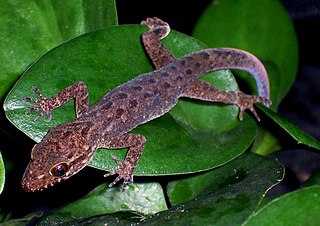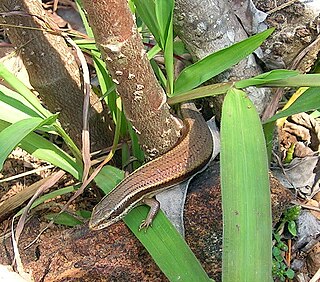
Gekko is a genus of Southeast Asian geckos, commonly known as true geckos or calling geckos, in the family Gekkonidae. Although species such as Gekko gecko are very widespread and common, some species in the same genus have a very small range and are considered rare or endangered.

Cyrtodactylus is a diverse genus of Asian geckos, commonly known as bent-toed geckos, bow-fingered geckos, and forest geckos. The genus has 361 described species as of 2024, which makes it the largest of all gecko genera.

Lygosoma is a genus of lizards, commonly known as supple skinks or writhing skinks, which are members of the family Scincidae. Lygosoma is the type genus of the subfamily Lygosominae. The common name, writhing skinks, refers to the way these stubby-legged animals move, snake-like but more slowly and more awkwardly.

Parvoscincus is a genus of skinks, lizards in the family Scincidae. The genus is endemic to the Philippines.

The genus Sphenomorphus – vernacularly also known as the common skinks – currently serves as a "wastebin taxon" for numerous skinks. While most or all species presently placed here are probably rather close relatives, the genus as presently delimited is likely to be not monophyletic and is in need of review. Some species in this genus have been moved to Pinoyscincus.

Lygosominae is the largest subfamily of skinks in the family Scincidae. The subfamily can be divided into a number of genus groups. If the rarely used taxonomic rank of infrafamily is employed, the genus groups would be designated as such, but such a move would require a formal description according to the ICZN standards.

Asthenodipsas is a genus of snakes of the family Pareidae.

Otosaurus cumingii, commonly called Cuming's sphenomorphus or the Luzon giant forest skink, is a species of skink, a lizard in the family Scincidae. The species is endemic to the Philippines.
Pinoyscincus is a genus of skinks, lizards in the family Scincidae. All species in the genus are endemic to the Philippines. Species in this genus were previously assigned to the genus Sphenomorphus.

Insulasaurus wrighti, also known commonly as Wright's sphenomorphus, is a species of skink, a lizard in the family Scincidae. The species is endemic to Palawan in the Philippines.
Parvoscincus beyeri, also known commonly as Beyer's sphenomorphus, is a species of skink, a lizard in the family Scincidae. The species is endemic to the Philippines.
The Aurora mountain skink is a species of lizard in the family Scincidae. The species is endemic to the Philippines.

Pinoyscincus abdictus is a species of skink, a lizard in the family Scincidae. The species is endemic to the Philippines. There are two recognized subspecies.
Cox's sphenomorphus is a species of skink, a lizard in the family Scincidae. The species is endemic to the Philippines. There are two recognized subspecies.

Jagor's sphenomorphus is a species of skink, a lizard in the family Scincidae. The species is endemic to the Philippines. There are two recognized subspecies.

Pinoyscincus llanosi, also known commonly as the Leyte sphenomorphus, is a species of skink, a lizard in the family Scincidae. The species is endemic to the Philippines.
The Mindanao sphenomorphus is a species of skink, a lizard in the family Scincidae. The species is endemic to the Philippines.
Tytthoscincus butleri, also known commonly as Butler's forest skink, is a species of lizard in the family Scincidae. The species is native to Malaysia and Thailand.
Tytthoscincus hallieri is a species of skink, a lizard in the family Scincidae. The species is native to Southeast Asia.
Tytthoscincus ishaki, also known commonly as the Tioman Island forest skink, is a species of lizard in the family Scincidae. The species is endemic to Tioman Island in Malaysia.












